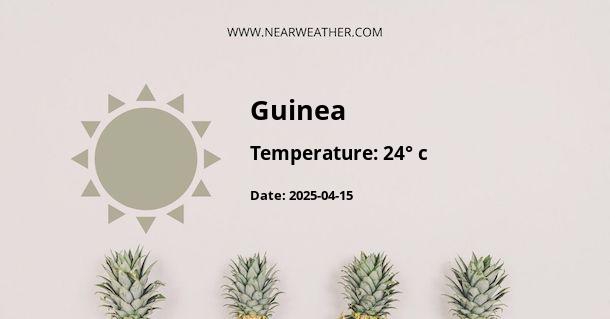Climate and Weather in the Republic of Guinea
The Republic of Guinea, located in West Africa, experiences a diverse range of climates and weather patterns throughout the year. The country is characterized by its tropical climate, influenced by its proximity to the Atlantic Ocean and its varied topography. Understanding the climate and weather of Guinea is important for tourists, researchers, and locals alike. Let's delve into the different seasons, temperatures, rainfall, and other climatic factors that define Guinea's weather patterns.
Seasonal Variations
Guinea experiences four distinct seasons: two dry seasons and two wet seasons. The Harmattan season occurs between November and February and brings dry and dusty winds from the Sahara Desert. The dry season follows, lasting from February to May, characterized by hot and dry conditions with minimal rainfall. This season is ideal for exploring Guinea's natural landscapes and wildlife.
The first wet season, known as the small rainy season, occurs from June to July. During this period, short but intense rain showers are common, providing relief from the dry season. The second dry season, which extends from August to October, is known as the major dry season. This season is characterized by high temperatures and low humidity, making it a challenging time for outdoor activities.
The long rainy season, also called the small dry season, lasts from October to November. This period brings more consistent and prolonged rainfall, transforming Guinea's landscapes into lush greenery. It is a great time for agriculture and exploring the country's waterfalls and rivers.
Temperature
Guinea experiences relatively high temperatures throughout the year, with minimal variation. The average annual temperature ranges between 24°C (75°F) and 29°C (84°F). However, during the dry season, temperatures can rise above 35°C (95°F) in some regions, particularly in the inland areas away from the cooling influence of the oceanic breeze.
The coastal regions, including the capital city Conakry, experience milder temperatures due to the oceanic influence. The coastal areas have average temperatures ranging from 25°C (77°F) to 30°C (86°F) throughout the year. The higher elevations in the Fouta Djallon region, such as the town of Labé, have slightly cooler temperatures due to the altitude, averaging around 20°C (68°F) to 25°C (77°F).
Rainfall
Rainfall patterns in Guinea vary significantly across the country. The coastal regions receive higher annual rainfall compared to the interior regions. The average annual rainfall in the coastal areas, including Conakry, ranges from 3,000mm (118 inches) to 4,000mm (157 inches), making it one of the wettest regions in West Africa.
As you move inland, the rainfall gradually decreases. In the central and eastern regions, such as Kankan and Nzérékoré, the average annual rainfall ranges from 1,500mm (59 inches) to 2,000mm (79 inches). The northern areas, such as Boké and Kindia, receive even less rainfall, with averages ranging from 1,000mm (39 inches) to 1,500mm (59 inches) annually.
Humidity
Guinea experiences high humidity levels throughout the year, particularly during the wet seasons. The coastal regions have a higher relative humidity, averaging around 80% to 90%. Inland areas also experience elevated humidity, but it tends to be slightly lower, ranging from 60% to 80%.
Extreme Weather Events
Guinea is occasionally affected by extreme weather events, such as tropical storms and hurricanes. These events are most likely to occur during the wet seasons, particularly between July and September. While the country is not directly in the path of major hurricanes, it can experience heavy rainfall, strong winds, and localized flooding as a result of these systems.
Climate Change and Adaptation
Like many countries around the world, Guinea is also grappling with the impacts of climate change. The changing climate patterns have the potential to disrupt agriculture, impact water resources, and increase the frequency and intensity of extreme weather events.
Efforts are being made at both national and international levels to adapt to these changes and mitigate their impacts. The government of Guinea is working on implementing sustainable practices, such as reforestation projects, to combat deforestation and promote climate resilience.
Conclusion
The Republic of Guinea experiences a tropical climate with distinct wet and dry seasons. The temperature remains relatively high throughout the year, with coastal regions benefiting from the cooling influence of the ocean. Rainfall varies across the country, with higher amounts along the coast and decreasing as you move inland. Understanding Guinea's climate and weather patterns is essential for planning activities, agriculture, and adapting to the impacts of climate change.
A - Guinea's Latitude is 11.000000 & Longitude is -10.000000.
A - Weather in Guinea is 25° today.
A - Climate Conditions in Guinea shows overcast clouds today.
A - Humidity in Guinea is 48% today.
A - Wind speed in Guinea is 6.34 km/h, flowing at 201° wind direction. today.
